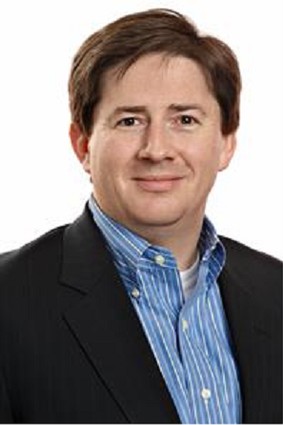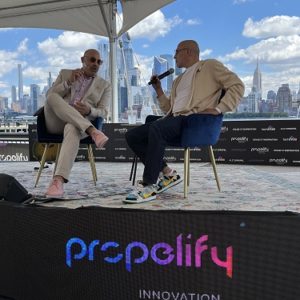Bell Labs Working on Future Technologies Right Here in New Jersey

Two years ago, under the direction of Marcus Weldon, Alcatel-Lucent Bell Labs began focusing again on big problems that required scientists to make real breakthroughs.
Weldon wanted to recapture the glory of the Bell Labs of decades past, the place that did bleeding-edge research in math, physics and chemistry, developed entire programming languages and operating systems, and had scientists who won Nobel Prizes.
“We call these ‘Future X’ projects,” Weldon explained, adding that the “X” in “Future X” has had multiple meanings. At one point it meant “10,” as Bell Labs was thinking about what the world needed to look like 10 years from then, and built the technologies to make it happen. Also, there were originally 10 such projects, Weldon noted, though there are now 13.
“X” also represented the unknown, he said. “In many of these projects, there is something that we don’t know how to do today, and we are going to have to invent new ways of doing things.” Finally, the solutions should be 10 times better than anything available today.
The first results of those projects will be unveiled at the end of 2015. They are all scheduled to deliver something remarkable, he said.
Weldon talked with NJTechWeekly.com about some of the research that was being done at Bell Labs’ “epicenter” in New Jersey, often in collaboration with researchers at other Bell Labs locations. “Generally, we do collaborate across a couple of sites because there are other pools of talent” that might be in France, Germany, Israel or Belgium, he said.
Qubit Quantum Computer
Probably the most remarkable research Weldon described was the technology involved in Bell Labs’ progress towards making a quantum computer called “Qubit.”
“Just like we invented the transistor in 1946, we are working to invent a Qubit device that will form the basis of a long-lived, stable quantum computer.”
Some researchers elsewhere have built very simple quantum computers using superconducting material and manipulating that material with electric and magnetic fields, he told us. The problem is that “those devices are not very stable,” and only last microseconds before they are “perturbed.”
Bell Labs has built devices that last for minutes by using a different approach called “topological quantum bits.” Weldon explained that a specific motion of a field is required to switch the device’s state, not just a random motion. If you make that motion, you can flip that state, but that motion never gets made randomly.
“This looks like it is showing very promising results, and could form the basis of a qubit structure which we are synthesizing. Either this year or next year, we will complete this.”
Assisted Thinking
This project was very hard for Weldon to describe. It uses advanced novel mathematics, “similarity” mathematics, to present just the information people need when they need it.
Unlike a typical Google search, which provides information but out of context, this technology looks at the relationship between you, other things and people like you, and shows a number of facts or answers that allow you to think more clearly about a problem.
“Think of this a little bit like the screen in the movie “Minority Report,” in which Tom Cruise is moving all those bits of information around,” Weldon said. It presents information to help you think, and you can move that information around, causing it to present a different view based on what you say is more important to you.
Bell Labs has been testing this approach, and “we are discovering all sorts of insights that are helping people figure out what it is they need, what they need to think about.” Some Bell Labs researchers are using Assisted Thinking to help with their research. Weldon envisions this kind of technology helping people to make better recommendations, find suitable career paths, and more.
Future Connect
Another promising project, Future Connect, is designed to supercharge 5 G (fifth generation wireless networks), using millimeter waves in the 20 to 100 gigahertz range. There is a large amount of spectrum available in that range and some of it may be licensed, Weldon said.
These waves typically travel only 10 meters, and so can be used as desk access points, not room access points. Millimeter waves were not originally of any interest to telecom companies because they are absorbed by walls and other dense structures.
“But you can get a large band of spectrum that you can use over a short distance,” Weldon explained. Bell Labs is looking at ways to extend these waves to 100 meters. Then companies could deploy small cell networks of millimeter wave nodes and bring ultra-broadband to users with at least 10 times today’s capacity, Weldon said.
This “high-frequency” approach can be complemented by a low-frequency approach using beamforming and “Massive MIMO” (also invented at Bell Labs) that allows the creation of a unique beam for each endpoint or user. So there will be multiple ways to support a per-user capacity of 1 Gbps or more capacity per user, both indoors and outdoors.
A New Network Air Interface for the Internet of Things
Bell Labs is also researching ways to make the network air interface, also known as the “radio layer,” better for machines in the Internet of Things. Long-Term Evolution (LTE) technology uses a protocol called “orthogonal frequency division multiplexing” (OFDM), which requires synchronization between the network and the device, but this consumes battery power. As machines need to last ten years on one battery, network-device synchronization can be very wasteful.
Bell Labs is developing a new approach to networking that doesn’t require synchronization with the network. “We are working on that in New Jersey to figure out how to connect the next 10 or 20 billion things,” Weldon said.
Weldon pointed to a use case that would incorporate both the new air interface and the Future Connect project. Think of a drone flying around that’s being controlled to monitor infrastructure like roads and bridges, looking for signs of degradation, or being used to record closeup images of an event.
“You could use the cellular frequency over a short range. You need low latency because you will have to control the drone in real time. The drone could zoom in and get very close, but it won’t collide with the object it is inspecting. However, if the drone is also taking photos, it will need lots of capacity. So it might use the millimeter wave spectrum to send video images and the new air interface to handle the controls.”
Universal Remote
Another Future X project, which Bell Labs is building in New Jersey and Belgium, is called “Universal Remote,” a converged access node that can be both wired and wireless at the same time. “Think of it as a small box which could have millimeter wireless capabilities, but also could have copper lines and maybe even cable lines coming out of it, so you have a universal remote. This would be one unified access node for all technologies.
“We think this will be the most efficient mode to deploy future capacity. You can take advantage of wires where you have them, wireless where you don’t, and you can tune the node to use a different amount of each.”
All in all, these projects form what Weldon calls the “foundation for the Future X Network,” which he believes will form the fabric of a new digital human existence characterized by the connection, control and collaboration of everything and everyone, everywhere. This new digital existence, when combined with new data-mining techniques like Assisted Thinking, will allow us to automate our lives, whether at work or at home, according to Weldon.

